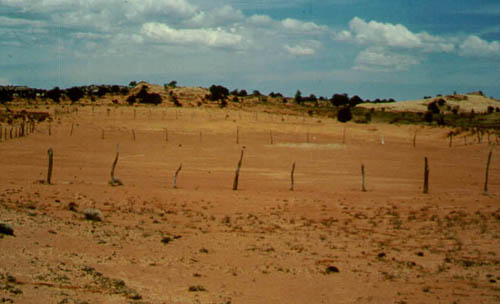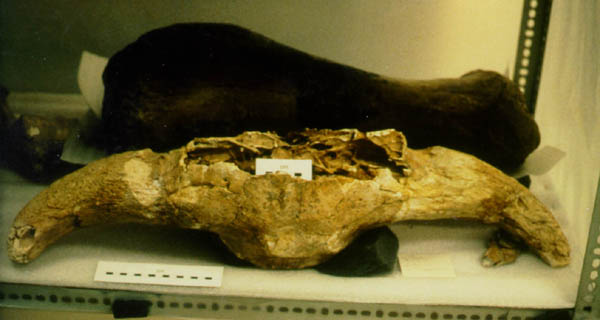India S. Hesse, SWCA, Inc., William J. Parry, Hunter College CUNY, and Francis E. Smiley, Northern Arizona University

In 1970, Bruce Harrill and Alexander Lindsay of the Museum of Northern Arizona discovered what appears to be a late Paleoindian campsite and cremation burial in a sandy blowout (see photo above) near Inscription House Trading Post in northeastern Arizona. Two lanceolate projectile points, more than 80 additional point fragments, more than 20 fragments of ground stone tools, a bison skull, and nearly 200 pieces of burned and mineralized bones–including fragments of highly burned human bone and teeth—were found in the vicinity of three charcoal-stained areas that may be hearths.
The flaked stone projectile points (see photo below) are lanceolate in shape, with straight to slightly concave bases and ground lower edges. Most have fine, parallel-oblique flaking patterns, and some are serrated. The raw materials include red, white, and gray cherts, as well as quartzites of medium- to fine quality. The number of bases represents a minimum of 20 points. Unfortunately, collecting by nearby residents has removed an unknown number of other specimens.
The Badger Springs points are not easily classified, but they do share characteristics with late Paleoindian points from the Rocky Mountains and the Great Plains, including the Angostura, Agate Basin, and Foothill-Mountain types. These point types have a combined age range of about 9,500 to 7,500 radiocarbon years ago, providing an age estimate for the Badger Springs points.
A striking feature of the artifact assemblage is that the majority of both the bones and the point fragments were affected by high heat. Numerous other flaked and ground stone tools were collected within the blowout, including biface fragments, a drill, a graver, a scraper, retouched flakes, cores and tested raw material, more than 250 pieces of flaking debris, and more than 20 fragments of small grinding slabs and manos. The faunal assemblage includes highly fragmented bones of large and small mammals, and a nearly complete skull of an extinct species of bison (probably B. occidentalis).

The various evidence points to Badger Springs being a campsite where a variety of activities took place, including manufacture of flaked stone tools, processing of seeds and/or pigments with grinding tools, and a cremation burial with a cache of projectile points left as an offering. Only a few Paleoindian cremations are known in North America, but burned human bones and burned projectile points have been found together at two sites in the upper Midwest. Caches of artifacts have also been found with Paleoindian flexed burials at several sites in western North America, with the bones and artifacts often covered with ochre (a red pigment). Further investigation of the Badger Springs site would provide the first glimpse of a post-Folsom Paleoindian campsite on the Colorado Plateau.
For more on the Badger Springs site and related topics, see:
Deller, D. Brian, and C. J. Ellis
1984 Crowfield: A Preliminary Report on a Probable Paleoindian Cremation in Southwestern Ontario. Archaeology of Eastern North America 12:41–71.
Frison, George C.
1991 Prehistoric Hunters of the High Plains (2nd ed.). Academic Press, San Diego.
1992 The Foothills-Mountains and the Open Plains: The Dichotomy in Paleoindian Subsistence Strategies Between Two Ecosystems. In Ice Age Hunters of the Rockies, edited by D. J. Stanford and J. S. Day, pp. 323–342. Denver Museum of Natural History and University Press of Colorado, Niwot.
Mason, Ronald J., and Carol Irwin
1960 An Eden-Scottsbluff Burial in Northeastern Wisconsin. American Antiquity 26(1):43–57.
Morris, Elizabeth A.
1958 A Possible Early Projectile Point from the Prayer Rock District, Arizona. Southwestern Lore 24(1):1–15.
Parry, William J., and Francis E. Smiley
1990 Hunter-Gatherer Archaeology in Northeastern Arizona and Southeastern Utah. In Perspectives on Southwestern Prehistory, edited by P. E. Minnis and C. L. Redman, pp. 47–67. Westview Press, Boulder.